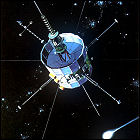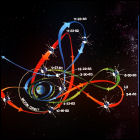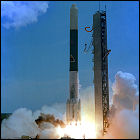Comet Giacobini-Zinner gets ICEd
 The International Cometary Explorer satellite – originally launched as International Sun-Earth Explorer 3 in 1978 – reaches the culmination of a series of complex orbital changes: a flyby of Comet Giacobini-Zinner, within 5,000 miles of the nucleus, primarily to sample and study the comet’s plasma tail and the interaction between that and the solar wind. ISEE-3 was not equipped with cameras at launch, so no imagery of the comet is obtained. The success of this flyby emboldens mission planners who hope to send it onward to study Halley’s Comet early in 1986, as part of a backup plan to use existing NASA spacecraft to study Halley in lieu of a specialized vehicle that would’ve been launched by space shuttle in 1986 (cancelled in the wake of the Challenger disaster).
The International Cometary Explorer satellite – originally launched as International Sun-Earth Explorer 3 in 1978 – reaches the culmination of a series of complex orbital changes: a flyby of Comet Giacobini-Zinner, within 5,000 miles of the nucleus, primarily to sample and study the comet’s plasma tail and the interaction between that and the solar wind. ISEE-3 was not equipped with cameras at launch, so no imagery of the comet is obtained. The success of this flyby emboldens mission planners who hope to send it onward to study Halley’s Comet early in 1986, as part of a backup plan to use existing NASA spacecraft to study Halley in lieu of a specialized vehicle that would’ve been launched by space shuttle in 1986 (cancelled in the wake of the Challenger disaster).
ISEE-3 to ICE
 Its primary mission satisfactorily completed, the NASA/ESA ISEE-3 (International Sun-Earth Explorer 3) satellite has a surplus of maneuvering fuel left over, and is given a new mission: it begins a series of over a dozen maneuvers utilizing both thrusters and gravity-assists, intended to push it out of its LaGrange point between Earth and the sun and toward a 1985 rendezvous with Comet Giacobinni-Zinner. Upon its final maneuver in 1983, ISEE-3 will be renamed ICE (International Cometary Explorer) and, after the complex series of course changes, will be perfectly targeted for its 1985 comet encounter.
Its primary mission satisfactorily completed, the NASA/ESA ISEE-3 (International Sun-Earth Explorer 3) satellite has a surplus of maneuvering fuel left over, and is given a new mission: it begins a series of over a dozen maneuvers utilizing both thrusters and gravity-assists, intended to push it out of its LaGrange point between Earth and the sun and toward a 1985 rendezvous with Comet Giacobinni-Zinner. Upon its final maneuver in 1983, ISEE-3 will be renamed ICE (International Cometary Explorer) and, after the complex series of course changes, will be perfectly targeted for its 1985 comet encounter.
ISEE-3
 The third in a series of three International Sun-Earth Explorer satellites, a joint effort between NASA and the European Space Agency, is launched aboard a Delta rocket from Cape Canaveral. Unlike the other ISEE satellites, ISEE-3 is intended to take up a “halo” orbit at the L1 LaGrangian point between the sun and Earth, the first man-made space vehicle to do so. There it will study the interaction between the solar wind and Earth’s own magnetosphere. Once its mission is completed in the early 1980s, it will be redirected and renamed to become the first Earth spacecraft to study a comet at close range.
The third in a series of three International Sun-Earth Explorer satellites, a joint effort between NASA and the European Space Agency, is launched aboard a Delta rocket from Cape Canaveral. Unlike the other ISEE satellites, ISEE-3 is intended to take up a “halo” orbit at the L1 LaGrangian point between the sun and Earth, the first man-made space vehicle to do so. There it will study the interaction between the solar wind and Earth’s own magnetosphere. Once its mission is completed in the early 1980s, it will be redirected and renamed to become the first Earth spacecraft to study a comet at close range.